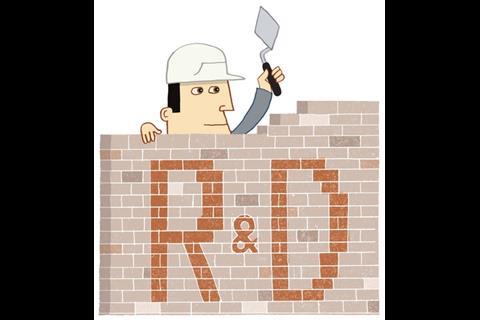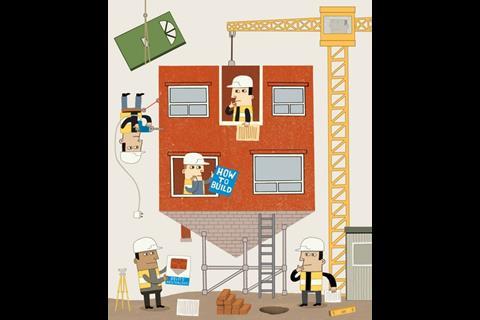Construction accounts for about 10% of GDP, so why is a measly £5m being invested in its R&D? Stephen Kennett looks at the steady evaporation of funding – particularly for the publication of practical guidance – but wonders if we only have ourselves to blame
As emergency services worked through the night to protect sub stations and water treatment plants during the floods of July last year, there were many in the construction industry who had already considered just such a scenario. Only months before, construction research body CIRIA had been trying to raise money to put together a report on the flood resilience of the UK’s infrastructure. Despite plenty of interest from companies in the industry, there were few who were prepared to get out their cheque books to help meet the cost of putting together the study.
As an industry not renowned for the money it spends on research and development, this might not be surprising, but in recent years things have been getting progressively worse. The crunch point came in 2003 when the government stopped funding sector-specific R&D. Up until this point it had invested £23m a year in the construction industry, money that now goes into the Technology Programme, where construction must compete with the likes of the aerospace and electronics.
Figures for government expenditure on R&D in construction show that £18m was invested in 2001. By 2005 this figure had fallen to £5.5m. Estimates now are anywhere between £5m and £10m, which principally comes from the Department of Innovation, Universities and Skills’ technology programme.
But this change in policy is just part of a steady decline in public funding of R&D in construction over the past 12-15 years. Some of the consequences are now being felt, and may already be eroding the value of public spending on construction, says Hywel Davies, technical director of CIBSE.
“For example, we know that average temperatures are increasing, and so we need to adapt building designs to cope with this. Where is the research into the benefits of high mass buildings, which are less susceptible to high daytime temperatures in summer? Fifteen years ago it would have been going on at BRE and shared with the industry. Now, it’s a struggle, and we are in danger of spending a lot of money on 3 million new homes without necessarily being sure how best to build them.”
So dire has the investment in construction R&D become that parliament has made it a key point in its inquiry into the construction industry, which was set up by the select committee for trade and industry – now the business, enterprise and regulatory reform committee.
According to Andrew Eastwell, chief executive of consultancy BSRIA, there is a misunderstanding about what is meant by R&D. “It’s not the sort of work carried on in laboratories by people in white coats. There is plenty of work going on at the technology level with generous government research funding for universities.”
Instead, what is missing is the funding for the more prosaic “how to” information that is used in day-to-day operations and it is a problem that is being exacerbated by the pace of new developments. In previous years this was assisted by co-funded programmes from agencies such as BRE (then a government body), the Property Services Agency, NHS Estates, the Electricity Council and projects supporting the Building Regulations.
Giving evidence at the inquiry’s recent oral session, the industry’s major research and technology organisations sought to put the withdrawal of funding into perspective by quoting figures for the number of technical guides and codes of practice published in 2006. These have dropped dramatically. BRE’s publications have gone from an average of 87 a year to 25. CIRIA managed 15 compared with its normal 35, and BSRIA produced just two, a 10th of its normal output. It’s a trend that the organisations say is directly attributable to the fall in government funding of R&D.
“One of the good aspects of the defunct Partners in Innovation programme was that it didn’t just deal with technology, it also dealt with process. The difficulty today is that most of the funding that is available is highly technology-focused,” says Eastwell. The Technology Strategy Board set up in July last year by the Department of Universities, Innovation and Skills does not support industry guidance because it is not “breakthrough technology”. “And there’s the rub, because a lot of what I’m saying is missing isn’t the technology, it’s the application of that technology, the understanding of what works and what doesn’t work.”
So why is the construction industry itself reluctant to invest money in R&D when industries such as manufacturing take it in their stride? According to Martin Wyatt, chief executive of BRE, there are several fundamental reasons. These partly revolve around the fact that clients buy projects rather than products. This makes it difficult for them to choose a building because it is the most technologically advanced design or specify an advanced model versus a standard model.
There is also the problem that it is almost impossible to protect intellectual property. “Basically anything you invent in terms of advanced process, new integration, a new way of doing things will be copied the next day by anybody who visits your site, and thus you cannot make that investment and protect it,” says Wyatt.
We are in danger of spending a lot of money on three million new homes without necessarily being sure how best
to build themHywel Davies, CIBSE
Added to this, the risk of getting things wrong often far exceeds any commercial benefits of doing things in an innovative way. “If you take all these things together and look virtually anywhere in the world, you will see the same low level of industry investment in R&D,” says Wyatt.
The other issue is the sprawling nature of the UK’s construction industry. “If you take something like the aerospace or automotive industry, you have a small number of big players. So the transition from academic research to market place is quite easy,” says Eastwell. “What is missing in construction is that process. In other words, trying to move from the innovation through to the normal practice.”
With the government being such a major client – 40% of the value of construction industry projects both in new building and repair and maintenance – there is an argument that it should take a lead in R&D investment. The large portfolio of government buildings presents a massive source of data for the industry.
“It could be used to understand how buildings are working and which innovations are working and which aren’t,” says Eastwell. After all, the government would benefit from making sure it is not wasting money on buildings that don’t work. In addition, as such a big player the rest of the industry would take notice of the results. “If you’ve got a large asset you would be critical of a business that didn’t look after it. And I’m being critical of government because I don’t think it is looking after it.”
Eastwell also advocates a change in the contractual process to allow a much longer period of activity – one to two years – after commissioning when the design team helps the client and the occupants to get to grips with their new building. “A prime sum would have to be allowed for at the outset of the project but the client would benefit and the designer could get feedback on what works and what doesn’t.”
The likelihood of the previous R&D funding for construction being reinstated is remote but there are options to tap into other funding streams that derive from the construction industry. These include the landfill tax credits, a proportion of which is set aside for research and development. With about one third of all landfill coming from the construction industry, there is theoretically around £75m available for R&D. This is distributed to various bodies including WRAP but the problem is that the funding is going into the cure rather than preventing waste in the first place. “WRAP’s brief is to increase the use of recycled materials, so although they receive the levy, they cannot sponsor the industry to reduce the amount that goes to landfill,” says Eastwell. “We can go to them for research funding on recycling materials but we cannot go to them for research funding on actually reducing the amount that goes to landfill in the first place. Why is it that we are spending £80m a year on something as narrow as recyclable materials and less than £5m on the whole of the construction industry which accounts for 10% of GDP?”
Another funding source is the climate change levy of which 10% goes to the Carbon Trust. “Buildings produce 40% of all carbon emissions or 50% if you take into account the embodied energy, but half of the carbon tax credits for R&D do not end up back in the industry,” says Wyatt.
Add to this the money earmarked for research from the aggregates levy, and there is about £169m of R&D funding raised each year. However, although some of this trickles down into the industry it’s not in a co-ordinated way, says Wyatt. “We would say that this can be achieved by some changes in priorities and getting more joined-up thinking across the government without further taxation.”
There is a growing realisation that up-to-date technical guidance and codes of practice produced by industry research bodies and institutions is rapidly drying up. A lack of supporting guidance for the Building Regulations has been one cause for concern. “The communities department does not have adequate resources to produce guidance to support the approved documents,” says Davies. “They look to the professional bodies and trade bodies to provide guidance, but there is limited money to support its production. The institutions are not set up to meet a shortfall in public spending, and trade bodies exist to further the business of their members, and may be felt to have an interest in what the guidance says.”
Eastwell’s concern is the next round of updates to things such as Part L. “Where’s the underpinning R&D and the knowledge base to support the revision due in 2010?”
It won’t be until late spring that the BERR inquiry makes its report. “They need a strong recommendation from an influential committee to get some action taken,” says Wyatt. Until then, the construction industry and its clients will continue to wait.
Postscript
What’s the best way to do R&D in construction? Email us at building@cmpi.biz or follow the “what you think” link.



























No comments yet